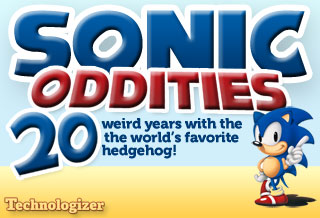 He’s Avis to Mario’s Hertz. Or, if you prefer, Pepsi to Mario’s Coke. He’s Sega’s Sonic the Hedgehog, and he turns twenty on Thursday. And even if you know more about him than I do, you don’t know everything there is to know about him. But you’ll learn a lot by exploring Benj Edwards’ “Sonic the Hedgehog Oddities,” which covers two decades of Sonic sidelights: his strange Sonic adventures, his mysterious work with Michael Jackson, his controversial contribution to the science of human genes, and much more.
He’s Avis to Mario’s Hertz. Or, if you prefer, Pepsi to Mario’s Coke. He’s Sega’s Sonic the Hedgehog, and he turns twenty on Thursday. And even if you know more about him than I do, you don’t know everything there is to know about him. But you’ll learn a lot by exploring Benj Edwards’ “Sonic the Hedgehog Oddities,” which covers two decades of Sonic sidelights: his strange Sonic adventures, his mysterious work with Michael Jackson, his controversial contribution to the science of human genes, and much more.
Tag Archives | Sega
Sonic the Hedgehog Oddities
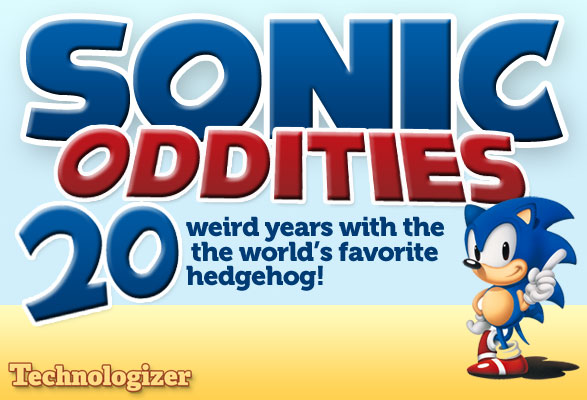 Twenty years ago, Sega took a bold gamble in its bid to unseat Nintendo as king of the console realm. The company released Sonic the Hedgehog for the Sega Genesis on June 23rd, 1991, unleashing the company’s speedy mascot onto the world for the first time.
Twenty years ago, Sega took a bold gamble in its bid to unseat Nintendo as king of the console realm. The company released Sonic the Hedgehog for the Sega Genesis on June 23rd, 1991, unleashing the company’s speedy mascot onto the world for the first time.
The iconic spiny mammal saved Sega’s console in its hour of need and spawned a massive franchise that spans dozens of releases for every Sega console (and plenty of non-Sega platforms since 1998). And whether we like it or not, Sonic started a trend of animal game characters with ‘tudes that continues to this day.
To celebrate the anniversary, I dove headfirst the annals of Sonic lore to pull out oddities for your entertainment.
3 comments
Happy (Almost) 10th Birthday, Sega Dreamcast!
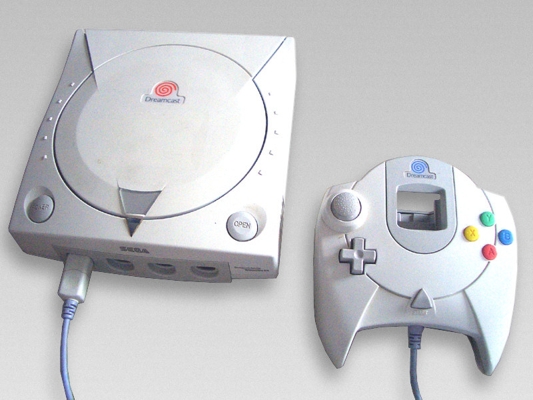 Next Wednesday will mark the Sega Dreamcast’s 10th birthday, having launched on September 9, 1999. Less than a year and a half later, Sega discontinued the console, facing competition from Sony’s Playstation 2, the looming threat of Microsoft’s Xbox and some friction within the company.
Next Wednesday will mark the Sega Dreamcast’s 10th birthday, having launched on September 9, 1999. Less than a year and a half later, Sega discontinued the console, facing competition from Sony’s Playstation 2, the looming threat of Microsoft’s Xbox and some friction within the company.
1UP editor Jeremy Parish is celebrating a little early with a retrospective. He does a good job of looking back on Sega the Console Maker, explaining why the Dreamcast was an important product — it had great games, mostly — and what led to its demise. But what really struck me while reading was how much the game console business has changed and solidified over the last 10 years.
Ever since Microsoft launched the Xbox in November 2001, we’ve been playing consoles from the same three manufacturers, with virtually no outside competition. That was unheard of in the 90s, which saw a handful of console makers come and go. The 3DO, Atari Jaguar, TurboGrafx-16 and Neo Geo all took a stab at the home console market, but either failed miserably or didn’t produce any progeny.
Sega was a different case because, as Parish points out, it had been around. Even before the Genesis fiercely competed with the Super Nintendo, there was the Sega Master System, and before the Dreamcast came the Sega Saturn. Sega’s exit from the console market was significant because it made room for Sony, Microsoft and Nintendo to dominate.
I don’t see any of those three manufacturers bowing out any time soon. If the Playstation 3, Xbox 360 and the Wii all stick to their goals of a 10-year life cycle, we’ll be looking at 15 years with the same three brands. The only competitors I see on the horizon are cloud gaming services such as OnLive and Gaikai.
That’s not a bad thing as long as everyone’s innovating. It just underscores how console gaming is no longer a wild and unpredictable industry. By dropping the Dreamcast, Sega made the transformation possible.
4 comments
Fifteen Classic Game Console Design Mistakes
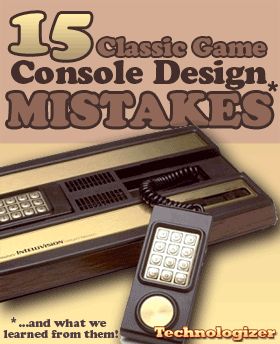
This list is by no means exhaustive, nor are all of these consoles bad overall (see The Worst Video Game Systems of All Time for that list). And though some of these problems keep popping up in one form or another–like the bad call of feeding power to the console via the RF switch shared by RCA’s Studio II and Atari’s 5200–other errors in judgments were unique to one console. Thank heavens for that.
191 comments
Classic Console Gaming Goes Portable
 Wandering the backwaters at E3 can yield some surprising finds, like the Hyperkin booth. The company, which sells accessories for most current and older-generation console systems, was showing off its month-old FC Mobile II, a portable game system that accepts original, 8-bit Nintendo Entertainment System cartridges. The $60 package includes a light gun and two wireless controllers, and can be connected to a television or played portably using the built-in 2-inch LCD screen.
Wandering the backwaters at E3 can yield some surprising finds, like the Hyperkin booth. The company, which sells accessories for most current and older-generation console systems, was showing off its month-old FC Mobile II, a portable game system that accepts original, 8-bit Nintendo Entertainment System cartridges. The $60 package includes a light gun and two wireless controllers, and can be connected to a television or played portably using the built-in 2-inch LCD screen.
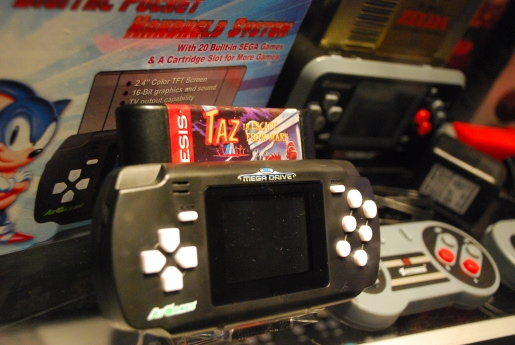 But 16-bit gamers don’t have to lament–starting this summer they’ll be able to play their favorite Sega Genesis or Master System cartridges on a unit Hyperkin plans to sell. The Sega model will also connect to a television or be playable on a tiny LCD, includes two built-in classic Sonic the Hedgehog games, and can play any other Genesis cartridges you find in dust-covered boxes in your closet or scrounge up at a garage sale.
But 16-bit gamers don’t have to lament–starting this summer they’ll be able to play their favorite Sega Genesis or Master System cartridges on a unit Hyperkin plans to sell. The Sega model will also connect to a television or be playable on a tiny LCD, includes two built-in classic Sonic the Hedgehog games, and can play any other Genesis cartridges you find in dust-covered boxes in your closet or scrounge up at a garage sale.
